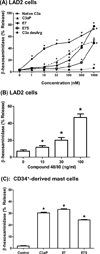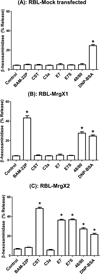G protein coupled receptor specificity for C3a and compound 48/80-induced degranulation in human mast cells: roles of Mas-related genes MrgX1 and MrgX2
- PMID: 21741965
- PMCID: PMC3169012
- DOI: 10.1016/j.ejphar.2011.06.027
G protein coupled receptor specificity for C3a and compound 48/80-induced degranulation in human mast cells: roles of Mas-related genes MrgX1 and MrgX2
Abstract
Although human mast cells express G protein coupled receptors for the anaphylatoxin C3a, previous studies indicated that C3a causes mast cell degranulation, at least in part, via a C3a receptor-independent mechanism similar to that proposed for polycationic molecules such as compound 48/80. The purpose of the present study was to delineate the receptor specificity of C3a-induced degranulation in human mast cells. We found that C3a, a C3a receptor "superagonist" (E7) and compound 48/80 induced Ca(2+) mobilization and degranulation in a differentiated human mast cell line, LAD2. However, C3a and E7 caused Ca(2+) mobilization in an immature mast cell line, HMC-1 but compound 48/80 did not. We have previously shown that LAD2 cells express MrgX1 and MrgX2 but HMC-1 cells do not. To delineate the receptor specificity for C3a and compound 48/80 further, we generated stable transfectants expressing MrgX1 and MrgX2 in a rodent mast cell line, RBL-2H3 cells. We found that compound 48/80 caused degranulation in RBL-2H3 cells expressing MrgX1 and MrgX2 but C3a did not. By contrast, E7 activated RBL-2H3 cells expressing MrgX2 but not MrgX1. These findings demonstrate that in contrast to previous reports, C3a and compound 48/80 do not use a shared mechanism for mast cell degranulation. It shows that while compound 48/80 utilizes MrgX1 and MrgX2 for mast cell degranulation C3a does not. It further reveals the novel finding that the previously characterized synthetic peptide, C3a receptor "superagonist" E7 activates human mast cells via two mechanisms; one involving the C3a receptor and the other MrgX2.
Copyright © 2011. Published by Elsevier B.V.
Figures




Similar articles
-
PMX-53 as a dual CD88 antagonist and an agonist for Mas-related gene 2 (MrgX2) in human mast cells.Mol Pharmacol. 2011 Jun;79(6):1005-13. doi: 10.1124/mol.111.071472. Epub 2011 Mar 11. Mol Pharmacol. 2011. PMID: 21441599 Free PMC article.
-
Mas-related gene X2 (MrgX2) is a novel G protein-coupled receptor for the antimicrobial peptide LL-37 in human mast cells: resistance to receptor phosphorylation, desensitization, and internalization.J Biol Chem. 2011 Dec 30;286(52):44739-49. doi: 10.1074/jbc.M111.277152. Epub 2011 Nov 8. J Biol Chem. 2011. PMID: 22069323 Free PMC article.
-
MrgX2 is a promiscuous receptor for basic peptides causing mast cell pseudo-allergic and anaphylactoid reactions.Pharmacol Res Perspect. 2019 Dec 2;7(6):e00547. doi: 10.1002/prp2.547. eCollection 2019 Dec. Pharmacol Res Perspect. 2019. PMID: 31832205 Free PMC article.
-
The Origin, Expression, Function and Future Research Focus of a G Protein-coupled Receptor, Mas-related Gene X2 (MrgX2).Prog Histochem Cytochem. 2015 Jul;50(1-2):11-7. doi: 10.1016/j.proghi.2015.06.001. Epub 2015 Jun 8. Prog Histochem Cytochem. 2015. PMID: 26106044 Review.
-
RBL cells as models for in vitro studies of mast cells and basophils.Immunol Rev. 2018 Mar;282(1):47-57. doi: 10.1111/imr.12628. Immunol Rev. 2018. PMID: 29431208 Review.
Cited by
-
Mast cell maturation is driven via a group III phospholipase A2-prostaglandin D2-DP1 receptor paracrine axis.Nat Immunol. 2013 Jun;14(6):554-63. doi: 10.1038/ni.2586. Epub 2013 Apr 28. Nat Immunol. 2013. PMID: 23624557 Free PMC article.
-
Store-Operated Calcium Entry via STIM1 Contributes to MRGPRX2 Induced Mast Cell Functions.Front Immunol. 2020 Jan 21;10:3143. doi: 10.3389/fimmu.2019.03143. eCollection 2019. Front Immunol. 2020. PMID: 32038646 Free PMC article.
-
Roles of Mas-related G protein-coupled receptor X2 on mast cell-mediated host defense, pseudoallergic drug reactions, and chronic inflammatory diseases.J Allergy Clin Immunol. 2016 Sep;138(3):700-710. doi: 10.1016/j.jaci.2016.04.051. Epub 2016 Jul 20. J Allergy Clin Immunol. 2016. PMID: 27448446 Free PMC article. Review.
-
β-Defensins activate human mast cells via Mas-related gene X2.J Immunol. 2013 Jul 1;191(1):345-52. doi: 10.4049/jimmunol.1300023. Epub 2013 May 22. J Immunol. 2013. PMID: 23698749 Free PMC article.
-
Roles for NHERF1 and NHERF2 on the regulation of C3a receptor signaling in human mast cells.PLoS One. 2012;7(12):e51355. doi: 10.1371/journal.pone.0051355. Epub 2012 Dec 20. PLoS One. 2012. PMID: 23284683 Free PMC article.
References
-
- Ahamed J, Haribabu B, Ali H. Cutting edge: Differential regulation of chemoattractant receptor-induced degranulation and chemokine production by receptor phosphorylation. J Immunol. 2001;167:3559–3563. - PubMed
-
- Ahamed J, Venkatesha RT, Thangam EB, Ali H. C3a enhances nerve growth factor-induced NFAT activation and chemokine production in a human mast cell line, HMC-1. J Immunol. 2004;172:6961–6968. - PubMed
-
- Ali H, Ahamed J, Hernandez-Munain C, Baron JL, Krangel MS, Patel DD. Chemokine production by G protein-coupled receptor activation in a human mast cell line: roles of extracellular signal-regulated kinase and NFAT. J Immunol. 2000;165:7215–7223. - PubMed
-
- Ali H, Richardson RM, Tomhave ED, Didsbury JR, Snyderman R. Differences in phosphorylation of formylpeptide and C5a chemoattractant receptors correlate with differences in desensitization. J Biol Chem. 1993;268:24247–24254. - PubMed
-
- Ali H, Richardson RM, Tomhave ED, DuBose RA, Haribabu B, Snyderman R. Regulation of stably transfected platelet activating factor receptor in RBL-2H3 cells. Role of multiple G proteins and receptor phosphorylation. J Biol Chem. 1994;269:24557–24563. - PubMed
Publication types
MeSH terms
Substances
Grants and funding
LinkOut - more resources
Full Text Sources
Other Literature Sources
Molecular Biology Databases
Miscellaneous

